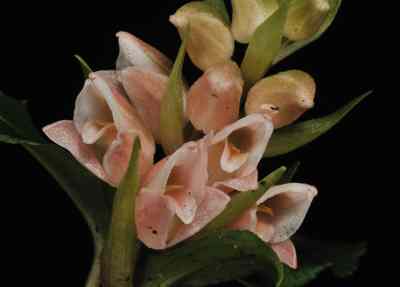The Plant
Terrestrial. Rhizomes ellipsoid to cylindrical, 3 to 6 cm long and 2 to 3 cm in width, fleshy, some with annular rings. Stem 3 to 5.f ft high, fleshy, glabrous, with several membranous, ovate, curving sheaths attached at regular intervals. Leafless. Flowers many, terminal.
The Flower
Flower diagonally erect, 1 to 1.25 cm across. Sepals unequal, ovate at the apex and its base connate; dorsal smaller than the lateral and arching over the petals, lateral diagonally spreading. Petals oblong, narrow and smaller than the lateral petals, arising from inside the connate base of sepals. Lip 3-lobed, oblong to ovoid, smooth, base clawed and apex margin irregularly fimbriate. Floral bract longer than the diagonally erect ovary, lanceolate, arising from the under side of the ovary.
The whole plant pale brown in colour with white parallel broken streaks and its bracts of a darker shade. Sepals pale green outside and greenish brown inside with many darker branching veins. Petals as same as that of the petals, but without veins. Lip pale greenish white turning white to its apex. Floral bract shades of brown.

The Pursuit
King and Pantling’s team of plant collectors were not able to collect this species from the region of Sikkim-Himalayas during their work. Hence, there was no mention of this species in their monumental work. Later on few works of the region had mentioned this species, but I was skeptical. However, I was determined to explore several areas for this species.
The mention of its altitudinal range in many publications guided me to search this species during the monsoon season. As this plant is easily noticeable with its height and the peculiar leafless character I enquired with many villagers about its presence. But, I was not able to find any information from anyone. As I was working in the alpine region during the year 2011, I had noticed three unusual pale brown stems spurting up. They were just few inches up and I was not able to identify them properly. I made a few visits in the coming days to ascertain what it is, but its growth rate was not quick enough to ascertain anything new. As those days were full of blooming activities, I was shuttling every day between different places and those this plant slipped of my mind. As I was finalising the monthly report I instantly remembered those three unusual stems and decided to visit the place the next day. On the following day, I made a trip to the location and found that all the three stems grew about 2 to 2.8 ft in height but were broken because of some animal grazing. The climax of finding this rare and unrecorded species was shattered as the plant was broken and dead. The presence and its identification of this e gave me enough motivation to look for it from the region.
Two more weeks went without any trace of this species. By that time the monsoon weakened and daily survey was more comfortable and I was concentrating on a new area, which was never visited by any researchers.
On the third day of my survey, I found a single plant of this species about 4 ft high and in buds. As I had never seen or studied this in their natural habitats, I was not able to come to a conclusion about its possible blooming dates. I searched the whole area for one more specimen in vain. As a precaution to protect the plant from possible wildlife movement my helper and I fenced the plant with locally available fallen branches. As the blooming dates were not confirmed I visited the plant every day until it bloomed and I produced this beautiful photograph. Later on, I worked in the region for three more years but never encountered this species even from the two locations it was found in 2011.
Reference:
There is no reference of this species in the The Orchids of the Sikkim-Himalayas by Sir. George King and Robert Pantling (1898).





